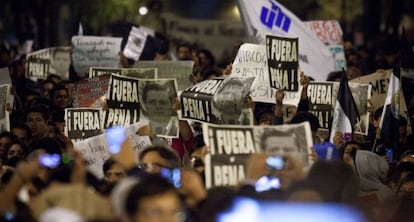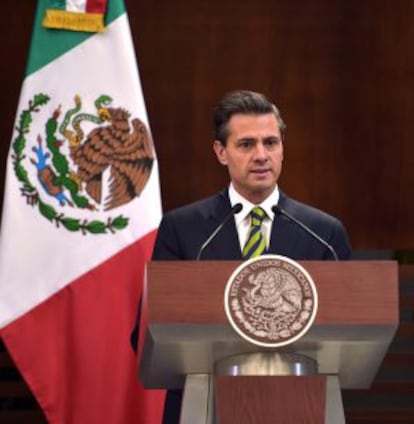Mexicans say “enough is enough” at massive protest rally
Tens of thousands from all walks of life call for changes to prevent another Iguala case


Night had already descended on the Zócalo when a thundering roar arose from the enormous central square in which countless chapters of Mexican history have unfolded.
To the furious cry of “They took them alive, we want them back alive!”, tens of thousands of people united their voices and pain over the tragedy of the 43 trainee teachers who were abducted by a criminal gang in late September.
The demand for a safe return that now almost nobody believes will happen – with its mix of absurdity and hope – starkly underscored the deep malaise affecting the nation.
Mexico is experiencing the largest wave of protests in recent years as a result of collective dissatisfaction and weariness at the violence and impunity in the country, for which the case of the missing Iguala students has been a catalyst. Ever since the trainee teachers were arrested by local police on September 26 and turned over to a criminal organization known as Guerreros Unidos, the tone of the protests has gone on increasing, with government buildings burnt down in the state of Guerrero by angry friends and relatives of the missing youths.
The anger reached its apex on Thursday, coinciding with the anniversary of the Mexican Revolution, when a huge crowd brought the heart of Mexico to a standstill. The protest had been organized by students at UNAM, Latin America’s largest university and a historical hotbed of political unrest in the capital.
Yet against all predictions, the backbone of the demonstration was made up not of relatives and colleagues of the missing students, but of people from a cross-section of society who were all angry enough to take to the streets.
Three separate columns began marching from different parts of the city – Plaza de las Tres Culturas in Tlatelolco, Ángel de la Independencia and the Monument to the Revolution – collecting thousands more followers throughout the afternoon as they slowly made their way to the Zócalo.
The diversity of the crowd made for a sharp contrast with earlier protests. This time entire families, senior citizens, hipsters, intellectuals and professionals joined the students and activists who had made up the core of the previous protests.
“The middle class showed up, and that’s new. They’re the ones who can effect change, who can organize their own indignation,” said Víctor, a 32-year-old editor.
The middle class showed up, and that’s new. They’re the ones who can effect change” Víctor, 32, editor
Karen, a 25-year-old psychology student who was wrapped in a Mexican flag, agreed. “We are sick and tired of many things, and we’re saying ‘enough is enough.’ This demonstration supports the struggle for change,” she said.
Asked if she really thought that the trainee students might still be alive, Karen admitted that she did not. “They are dead, we know it. But when we say we want them back alive, what we are really asking for is no more missing people,” she explained.
The sense of hope for national regeneration was palpable. Many of the people who joined the march were doing so for the first time. Their anger had been building up for weeks and they needed a peaceful outlet for it. “Look, the efforts of civil society have always come to nothing,” said Diego, a 38-year-old musician. “This time I would like to believe that the government will react when it sees this. Otherwise, everything is going to get worse.”
When the demonstrators converged on Zócalo square, relatives of the missing youths began rousing the crowd from a stage. Their words were full of rage and they refused to accept that the students were dead. Time and again they demanded government action to find them.
“We’re not tired, we are sick and tired!” yelled one father to a crowd, which responded by counting out loud to 43. The chant seemed to put a figure on the pain, and many of those present at the square had the feeling they were taking part in history.

The crowd began to break up around 8pm, when it became completely dark. All the while, security forces remained at a prudent distance from the demonstrators and did not intervene, aware that the slightest spark could trigger an explosion.
The authorities’ greatest fear was the possibility of an attack on the National Palace, whose walls face the Zócalo – fueled by the burning of a door there two weeks ago by radicals. On Tuesday, President Enrique Peña Nieto issued a warning against the use of violence and attacks on public spaces. “Under the cover of the social consternation over the painful and horrific events [...] we have noticed violent movements that appear to seek destabilization, social disorder and, above all, to attack the national project we have been encouraging,” he warned.
Once the march was over and people began quietly going home, content in the knowledge that they had been part of a momentous event, an uncontrolled group of protestors remained behind and started several bonfires in front of the National Palace, immediately setting hundreds of police officers into motion. The ensuing confrontation between dozens of hooded activists and law enforcement officers lasted several hours. Everyone else had gone home, but the violence was not quite over.
Tu suscripción se está usando en otro dispositivo
¿Quieres añadir otro usuario a tu suscripción?
Si continúas leyendo en este dispositivo, no se podrá leer en el otro.
FlechaTu suscripción se está usando en otro dispositivo y solo puedes acceder a EL PAÍS desde un dispositivo a la vez.
Si quieres compartir tu cuenta, cambia tu suscripción a la modalidad Premium, así podrás añadir otro usuario. Cada uno accederá con su propia cuenta de email, lo que os permitirá personalizar vuestra experiencia en EL PAÍS.
En el caso de no saber quién está usando tu cuenta, te recomendamos cambiar tu contraseña aquí.
Si decides continuar compartiendo tu cuenta, este mensaje se mostrará en tu dispositivo y en el de la otra persona que está usando tu cuenta de forma indefinida, afectando a tu experiencia de lectura. Puedes consultar aquí los términos y condiciones de la suscripción digital.








































